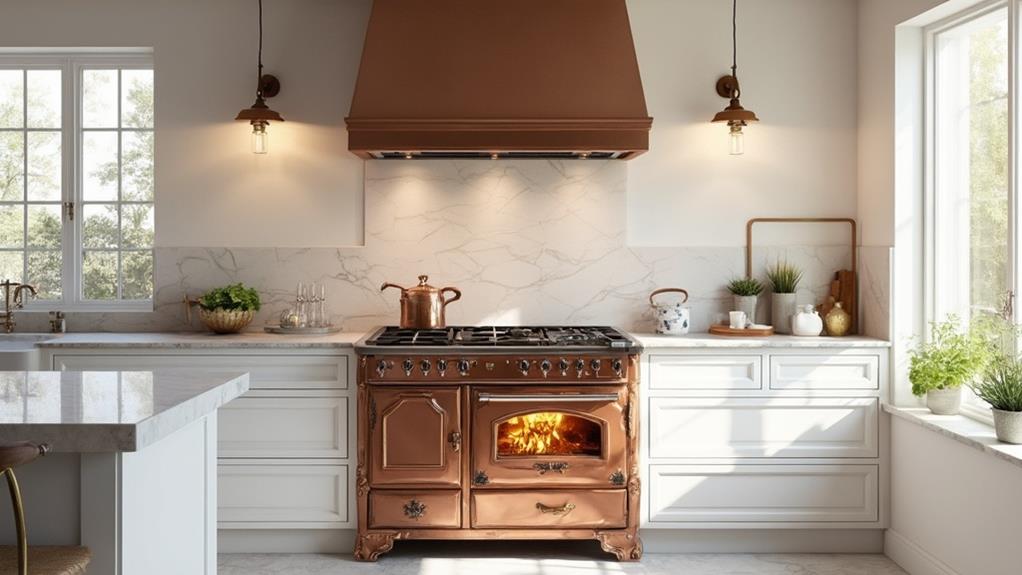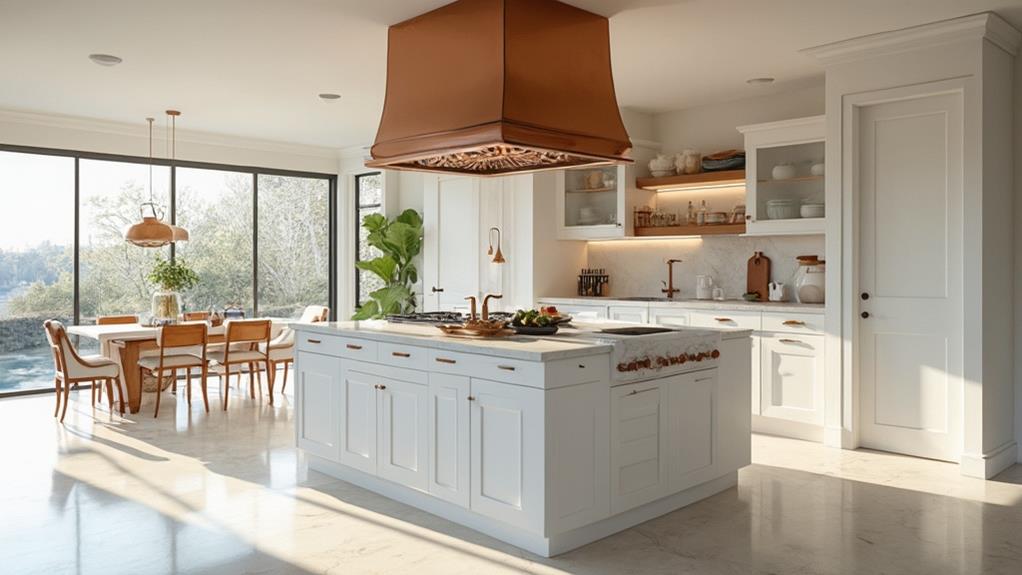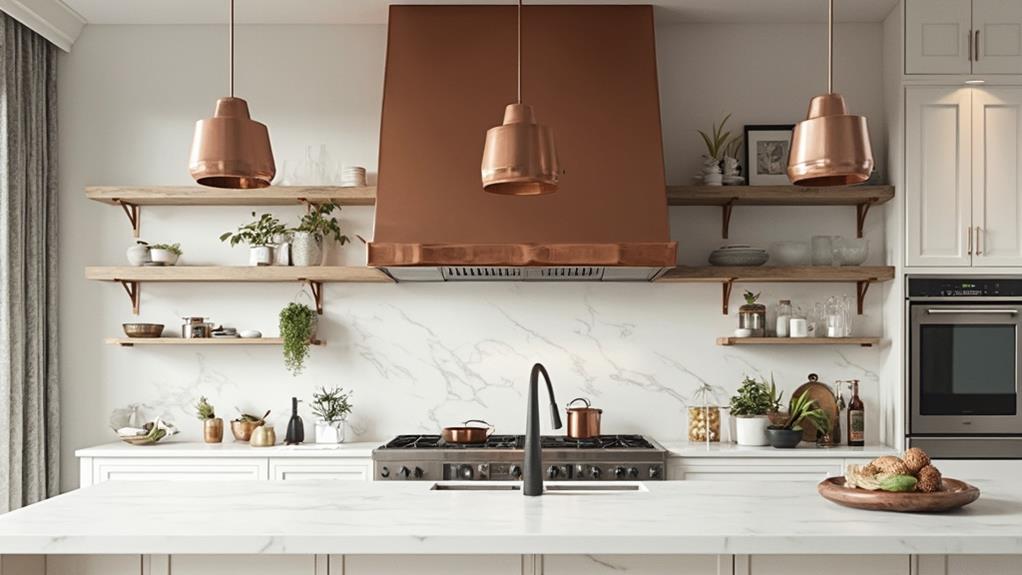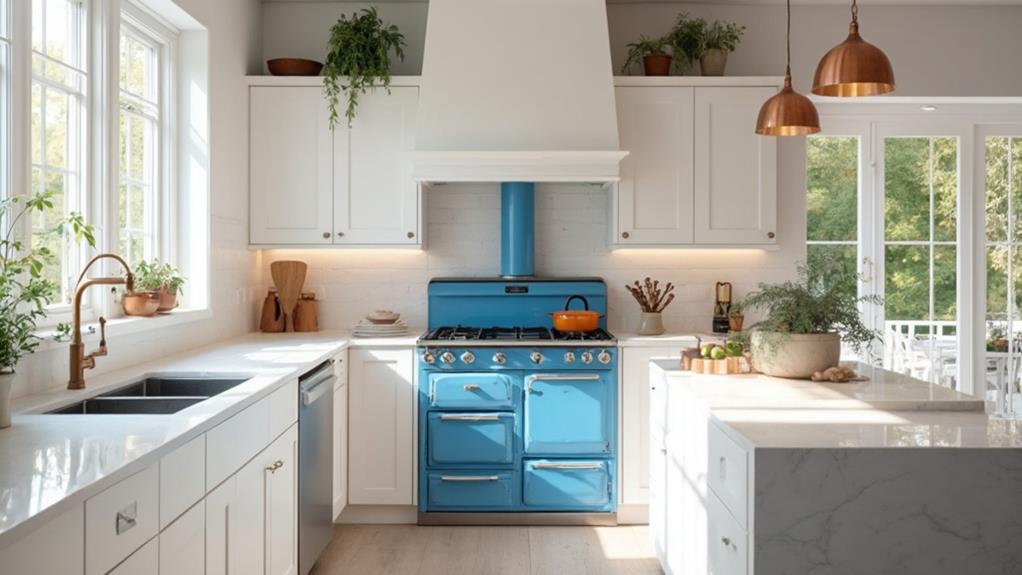When designing a kitchen around a statement piece, you'll want to choose an item with visual impact, functionality, and personal significance. Start by identifying the dominant colors in your statement piece to create a cohesive color scheme. Plan your layout carefully, positioning the focal point strategically and ensuring smooth workflow. Select complementary design elements that support the statement piece without competing for attention. Balance aesthetics with functionality by incorporating storage solutions and lighting that enhance the overall design. Remember to consider the size and scale of your statement piece in relation to the kitchen's dimensions. There's much more to explore in creating your perfect kitchen centerpiece.
Choosing Your Statement Piece

When selecting a statement piece for your kitchen, consider three key factors: visual impact, functionality, and personal significance. Your chosen item should command attention and serve as a focal point, whether it's a vibrant retro refrigerator, an antique farmhouse sink, or a custom-built kitchen island.
Ensure your statement piece aligns with your overall design aesthetic while offering practical value. A large, ornate range hood might look stunning, but it should also effectively ventilate your cooking space. Similarly, a vintage butcher block island can provide both character and additional workspace.
Don't overlook the emotional connection to your statement piece. Perhaps it's a cherished family heirloom or an item that reflects your passion for cooking. This personal touch will make your kitchen truly unique and meaningful.
Consider the size and scale of your statement piece in relation to your kitchen's dimensions. A massive chandelier might overwhelm a small space, while a petite vintage cart could get lost in a large kitchen. Balance is key.
Lastly, think about how your statement piece will interact with other elements in the room. It should complement, not clash with, your cabinetry, countertops, and flooring.
Color Coordination and Harmony
With your statement piece selected, it's time to consider the color palette that'll bring your kitchen design to life. Start by identifying the dominant colors in your chosen piece. These will serve as the foundation for your kitchen's color scheme.
If your statement piece is bold, opt for neutral tones in the surrounding elements to create balance. Conversely, if it's more subdued, you can introduce pops of color elsewhere.
Consider the 60-30-10 rule when coordinating colors. Use your primary color for 60% of the space, a secondary color for 30%, and an accent color for the remaining 10%. This approach ensures visual harmony while preventing the space from feeling overwhelming.
Don't forget to factor in the undertones of your chosen colors to ensure they complement each other seamlessly.
Experiment with different shades and tones within your chosen palette to add depth and interest. You can use lighter versions of your primary color on walls and darker shades for cabinetry or vice versa.
Remember that lighting plays a crucial role in how colors appear, so test your choices under various lighting conditions before making final decisions.
Layout and Space Planning

Once you've chosen your statement piece and color scheme, it's crucial to consider how they'll fit into your kitchen's overall layout. Start by determining the focal point where your statement piece will shine. If it's a vibrant range hood, position it centrally on a wall. For a striking island, place it in the heart of the kitchen.
Next, plan your work triangle – the path between your sink, stove, and refrigerator. Ensure this triangle flows smoothly around your statement piece without obstruction. You'll want to maintain adequate clearance for foot traffic and appliance doors.
Consider sight lines when arranging other elements. Don't let cabinets or tall appliances block the view of your statement piece from key areas like the dining room or living space. Instead, use lower-profile elements to frame and accentuate it.
If your statement piece is functional, like a unique sink or cooktop, integrate it seamlessly into your workflow. Surround it with ample counter space and storage to maximize efficiency.
Remember to balance visual weight. If your statement piece is large or bold, keep surrounding elements simpler to avoid overwhelming the space. This thoughtful layout will ensure your kitchen is both beautiful and functional.
Complementary Design Elements
As you integrate your statement piece into the kitchen layout, it's essential to consider complementary design elements that will enhance its impact. Start by selecting a color palette that harmonizes with your focal point. If your statement piece is bold, opt for neutral tones elsewhere to avoid overwhelming the space. Conversely, if it's subtle, you can introduce pops of color through accessories or backsplash tiles.
Lighting plays a crucial role in highlighting your statement piece. Consider installing adjustable spotlights or pendant lights to draw attention to it. Choose fixtures that complement the style of your focal point, whether it's modern, rustic, or traditional.
Pay attention to textures and materials throughout the kitchen. If your statement piece is sleek and glossy, incorporate matte finishes elsewhere for contrast. Mix metals, woods, and stones to create a layered, cohesive look.
Don't forget about the surrounding cabinetry and countertops. Select styles and finishes that support your statement piece without competing for attention. Simple, clean lines often work best to let your focal point shine.
Balancing Functionality and Aesthetics

The art of balancing functionality and aesthetics is crucial when designing a kitchen around a statement piece. While your eye-catching focal point sets the tone, you'll need to ensure the space remains practical for everyday use.
Start by considering the kitchen work triangle – the relationship between your sink, stove, and refrigerator. Don't let your statement piece disrupt this essential flow.
Incorporate storage solutions that complement your statement piece without overshadowing it. Use a mix of open shelving and closed cabinets to maintain visual interest while providing ample storage. Choose appliances that blend seamlessly with your design aesthetic, opting for panel-ready models or finishes that coordinate with your statement piece.
Don't forget about lighting. Strategically placed task lighting will enhance functionality, while accent lighting can highlight your statement piece. Consider dimmable options to create ambiance without compromising practicality.
Lastly, select materials and finishes that are both beautiful and durable. Your kitchen should withstand daily wear and tear while maintaining its visual appeal. By carefully balancing these elements, you'll create a kitchen that's not only stunning but also highly functional.
Conclusion
You might worry that a statement piece will overwhelm your kitchen, but don't let that stop you. By carefully considering color, layout, and complementary elements, you'll create a harmonious space that's both functional and stunning. Remember, it's all about balance. Your statement piece should be the star, but not the whole show. With thoughtful design, you'll have a kitchen that's uniquely yours and a joy to spend time in.

